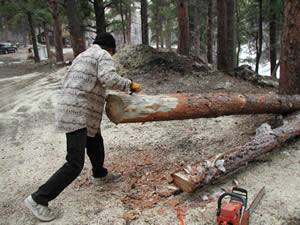In the past, before the easy availability of lumberyards and finished materials, a drawknife was an important tool. They can still be purchased new and found in garage sales and antique shops. If you intend to do any woodwork after a disaster, they are something you should own and learn to use.
A drawknife is a traditional woodworking hand tool used to strip bark off logs and shape wood by removing shavings. It consists of a blade with a handle at each end. The blade of a drawknife is usually long and narrow with a beveled, or angled, side and one flat side. The handles at each end of the blade are usually perpendicular or continuous with the blade. Long drawknives are typically used for tasks such as debarking logs and shorter knives are used for finer woodwork.

A drawknife is often used to debark trees, or to create roughly rounded or cylindrical billets to finish on a wood lathe. It can be used to flatten wood to make planks. They work best on green wood. Green wood is wood that is still moist because it has not been dried.
To use a drawknife, you grip both handles and draw the knife along the wood toward your body. The downward pressure on the handles determines the depth of the cut. For ease and safety reasons, the beveled edge of the blade is usually angled upward and the blade is rarely pushed away from the body.
When using a drawknife work from the center of the piece to the end, not the entire length all at once. The operator then reverses the piece in the shaving horse and works the other end.
Shaving smaller pieces of wood with a drawknife is usually done while seated at a shaving horse. A shaving horse is a bench that clamps the wood in place. You straddle the bench and step on a bar that causes the clamp to hold down on the woodwork. (I will post plans for a shaving horse tomorrow)
A common uses for a drawknife is stripping bark. Smaller logs are locked in place with a vise or a shaving horse; larger logs may stay in place from their own weight. To debark pull the blade with consistent pressure and fast movements toward your body, repositioning the log as needed.
There are quite a few different styles and shapes of drawknives; find out what works best for your purposes. This is a tool that requires a certain amount of skill, get your drawknives now and learn to use them.
Howard



I need someone to operate a drawknife LOL
Great writeup!
I grew up using a drawknife, and still own two of them.
My father was a welder by trade, and would make tomahawk heads for my brothers and me. We had to make our own handles, though. Using the drawknife, my brothers and I would shape a hickory limb or a scrap piece of lumber into a serviceable handle. And since we HAD to throw them, and abuse them like any boy would, we replaced handles often.
A hand tool with a broken handle becomes a paperweight. The ability to make a decent handle extends your ability to make it through a disaster.
Peace,
db
For peeling bark I’ve found a relatively easy way – if you’re not in a hurry. I peel a strip off opposite sides of the log and put it aside. Later, the entire sheet of bark will just peel off in huge chunks. Apparently doing it the way I do allows the bark to loosen naturally.